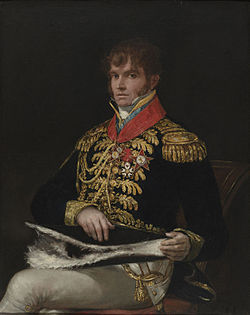| Royal Order of Spain | |
|---|---|
 Cross and sash of the order as depicted in the Vinkhuijzen Collection | |
| Awarded by the King of Spain | |
| Type | State Order |
| Established | 20 October 1808 |
| Royal house | House of Bonaparte |
| Motto | Virtute et Fide |
| Awarded for | Bravery on the battlefield as well as for civilian accomplishments |
| Status | Obsolete |
| Founder | Joseph Bonaparte |
| Grades | Grand cross (grand cordon) Commander (commandeur) Knight (chevalier) |
| Ribbon of the order | |
The Royal Order of Spain, originally founded as Ordre royal d'Espagne is an extinct order of knighthood of the Kingdom of Spain founded by Joseph Bonaparte.
Contents
